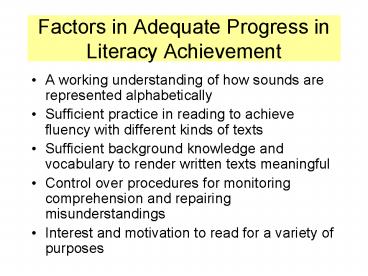Factors in Adequate Progress in Literacy Achievement PowerPoint PPT Presentation
1 / 10
Title: Factors in Adequate Progress in Literacy Achievement
1
Factors in Adequate Progress in Literacy
Achievement
- A working understanding of how sounds are
represented alphabetically - Sufficient practice in reading to achieve fluency
with different kinds of texts - Sufficient background knowledge and vocabulary to
render written texts meaningful - Control over procedures for monitoring
comprehension and repairing misunderstandings - Interest and motivation to read for a variety of
purposes
2
Purposes of Phonics Instruction
- Establishes grapheme-phoneme relationships and
the use of graphophonics cues in reading. This is
termed the alphabetic principle. - Develops word recognition based on their visual
and orthographic features. This process is called
decoding. - Aids in building reading fluency and
automaticity.
3
The Phonics Approach
- Gradual movement into word units and
comprehension - Sound/letter correspondence foundation
established - Sight-word instruction only for words not
decodable by phonics - Emphasizes smaller than word level language units
4
Phoneme to Grapheme Relationships
One-to-many relations
a
/1/
b
Many-to-one relations
/1/
a
/2/
5
English Phonics
- Consonants and vowels
- Consonant blends and digraphs
- Long and short vowels
- R-controlled vowels
- Vowel digraphs
- Diphthongs
- Homophones homographs
6
English Syllable Patterns
- Closed Short vowel ending with consonant
- Open Long vowel, no consonant ending
- Vowel Digraph vowel spelled with 2 letters
- C-le at the ends of words
- R-controlled vowel
- Vowel-consonant-e long vowel pattern
- Idiosyncratic
7
Word Derivations
immigrate
migration
immigration
migrate
immigrant
migr-move
migratory
emigrate
migrancy
emigrant
emigration
8
Traditional Approaches to Phonics Instruction
- Are synthetic approaches using part to whole with
segmentation and blending of letters into words - Begin with teaching individual letters and
letter-sound correspondences - May involve kinesthetic activities, i.e.,
Orton-Gillingham, Zoo Phonics - Require direct instruction based on a behavioral
analysis of decoding. I.e., Distar
9
Contemporary Phonics Approaches
- Spelling-based principles such as Word Study or
Making Words that involve sorting or making words
based on students developmental level - Analogy-based approaches where students decode
words based on known words or word parts - Embedded phonics where students where instruction
occurs in the context of authentic reading and
writing experiences
10
Word Study(Bear, Invernezzi, Templeton
Johnston)
- Picture sorts
- Concept sorts
- Letter-sound correspondence sorts
- Same-vowel word families
- Mixed-vowel word families
- Word Hunt
- Word Bank
- Word Wall
- High-frequency word study
- Word strips
- Word Study Notebooks
- Dictation
- Word games

